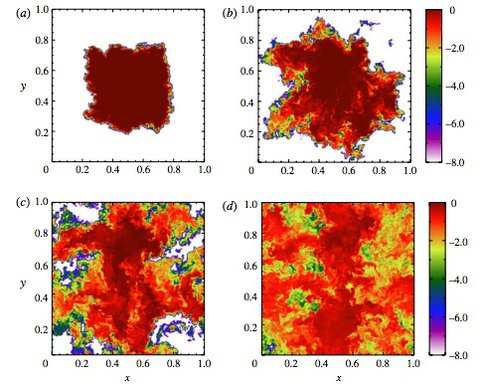2012 Annual Science Report
 Arizona State University
Reporting | SEP 2011 – AUG 2012
Arizona State University
Reporting | SEP 2011 – AUG 2012
Astrophysical Controls on the Elements of Life, Task 5: Model the Variability of Elemental Ratios Within Clusters
Project Summary
This project aims to better understand the self-enrichment that goes on in star-forming molecular clouds as stars near the end of their lives and deposit heavy elements into the surrounding medium, where other stars are still in the midst of forming. Through detailed hydrodynamic simulations we are studying the mixing of heavy elements and its relation to variable abundance ratios in present-day clusters, as well as the transition from pristine to enriched star formation in the early universe.
Project Progress
The past year has led to a new published article related to this topic, and a second article in preparation and nearing submission. In the first work (Pan et al 2012), we brought in a new collaborator, John Scalo, from UT Austin and extended our simulations of the mixing of material by supersonic turbulence to study the self-enrichment of star forming regions in the early universe. Here we derived new results constraining the transition from primordial star formation, in which stars are made purely of hydrogen and helium, to “Pop II” star formation, in which stars are enriched with heavy elements and surrounded by protostellar disks that may form planets. A follow up work, extending these simulations over a larger variety of conditions and parameterizing them for use in subgrid models in larger-scale simulations is currently in preparation and expected to be submitted to the Astrophysical Journal by the end of the calendar year.
The mixing of heavy elements into an initially pristine turbulent region with a Mach number of 0.9. Colors are apportioned according to a log scale that goes down to 10^-8 of the concentration in the initially polluted region.
The frames are taken at 0.12, 0.5, 0.9 and 1.5 dynamical times. The figure illustrates that unpolluted regions persist for a significant time in turbulently mixed regions such as molecular clouds in primordial galaxies. This is a reproduction Figure 1 in L. Pan, E. Scannapieco, & J. Scalo, 2012, which gives more details about these simulations
Publications
-
Pan, L., Scannapieco, E., & Scalo, J. (2012). The pollution of pristine material in compressible turbulence. Journal of Fluid Mechanics, 700, 459–489. doi:10.1017/jfm.2012.143
-
PROJECT INVESTIGATORS:
-
PROJECT MEMBERS:
Liubin Pan
Postdoc
-
RELATED OBJECTIVES:
Objective 1.1
Formation and evolution of habitable planets.
Objective 3.1
Sources of prebiotic materials and catalysts

